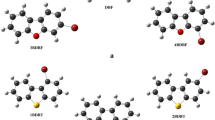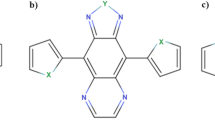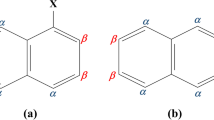Abstract
After the separation of the donor, the acceptor, and the σ-type bridge from the π-σ-π system, the geometries of biphenyl, biphenyl anion radical, naphthalene, and naphthalene anion radical are optimized, and then the reorganization energy for the intermolecular electron transfer (ET) at the levels of HF/4-31G and HF/DZP is calculated. The ET matrix elements of the self-exchange reactions of theπ-σ-π systems have been calculated by means of both the direct calculation based on the variational principle, and the transition energy between the molecular orbitals at the linear coordinateR = 0.5. For the cross reactions, the ET matrix element and the geometry of the transition state are determined by searching the minimum energy splitting Δmin along the reaction coordinate. In the evaluation of the solvent reorganization energy of the ET in solution, the Marcus’ two- sphere model has been invoked. A few of ET rate constants for the intramolecular ET reactions for the π-σ-π systems, which contain the biphenylyl as the donor and both biphenylyl and naphthyl as the acceptor, have been obtained.
Similar content being viewed by others
References
Barbara, P. F., Meyer, T. J., Ratner, M. A., Contemporary issues in electron transfer research,J. Phys. Chem., 1996, 100: 13148.
Miller, G. L., Calcaterra, L. T., Green, N. J. et al., Distance, stereoelectronic effects, and the Marcus inverted region in intramolecular electron transfer in organic radical anions,J. Phys. Chem., 1986, 90: 3673.
Miller, J. R., Paulson, B. P., Bal, R. et al., Torsional low-frequency reorganization energy of biphenyl anion in electron transfer reactions,J. Phys. Chem., 1995, 99: 6923.
Bobrowski, K., Holeman, J., Poznanski, J. et al., Pulse radiolysis studies of intramolecular electron transfer in model peptides and proteins. 5. Trp.→Tyr. radical transformation in H-Trp-(pro)n-Tyr-OH series of peptides,J. Phys. Chem., 1992, 96: 10036.
Braga, M., Larson, S., Electronic factor for electron transfer through cyclohexane-type spacer,J. Phys. Chem., 1993, 97: 8929.
Siddarth, P., Marcus, R. A., Electron transfer in proteins: an artificial intelligence approach to electronic coupling,J. Phys. Chem., 1993, 97: 2400.
Yoshimura, A., Nozaki, K., Ikeda, N. et al., Photoinduced electron transfer and back electron transfer within binuclear complexes of Ru(II) andCo(III),J. Am. Chem. Soc., 1993, 115: 7521.
Li Xiangyuan, He Fucheng, Electron transfer NO2 ++NO→ N02+NO+ in aromatic nitration,Science in China, Ser. B, 1997, 40 (5): 523.
Li Shunlai, Li Zonghe, Xu Huijun, The theoretical study of the intramolecular electron transfer reactions for a series of organic systems,Science in China (in Chinese), Ser. B, 1997, 27(4): 325.
Takei, Y., Yamaguchi, T., Osamura, Y. et al., Electronic spectra and molecular structure of biphenyl and para-substituted biphenyls in a supersonic jet,J. Phys. Chem., 1988, 92: 577.
Rubio, M., Merchan, M., Orti, E., The internal rotational barrier of biphenyl studied with multiconfigurational second-order perturbation theory (CASPT2),Theor. Chim. Acta, 1995, 91: 17.
Eberson, L., Radner, F., Electron transfer reaction in organic chemistry, VI. Possible role of electron transfer in aromatic nitration by nitrosonium and nitronium ion,Acta Chem. Scand., 1984, B38: 861.
Farazdel, A., Dupuis, M., Clementi, E. et al., Electric field induced intramolecular electron transfer in spiro π-electron systems and their suitability as molecular electronic devices, A theoretical study,J. Am. Chem. Soc., 1990, 112: 4206.
Li, X. Y., Tian, A. M., He, F. C. et al., Electron transfer integral between two zero-overlap states,J. Comput. Chem., 1996, 17: 1108.
Rodriguez-Monge, L., Larson, S., Conductivity in polyacetylene. 3.Ab initio calculations for a two-site model for electron transfer,J. Phys. Chem., 1996, 100: 6298.
Dupuis, M., Marquez, A., Davidson, E. R.,“HOND095.6”, New York: IBM Corporation, 1995, 12401.
Author information
Authors and Affiliations
Additional information
Project supported by the National Natural Science Foundation of China (Grant Nos. 29706104 and 29573112), the State Key Laboratory of Theoretical and Computational Chemistry of Jilin University.
Rights and permissions
About this article
Cite this article
Li, X., Xiao, S. & He, F. Ab initio study of long-range electron transfer between biphenyl anion radical and naphthalene. Sc. China Ser. B-Chem. 42, 441–448 (1999). https://doi.org/10.1007/BF02873974
Received:
Issue Date:
DOI: https://doi.org/10.1007/BF02873974




